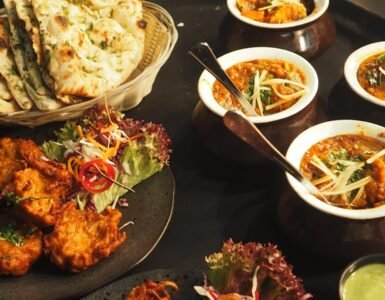Introduction to Culinary Road Trips
The concept of culinary road trips has gained significant traction in recent years, engaging food enthusiasts and travelers alike in a journey that delves into regional culinary delights. These adventures allow individuals to explore diverse geographic areas through their authentic cuisine, offering a profound understanding of local traditions, flavors, and ingredients. More than just a quest for delicious meals, culinary road trips serve as a gateway to experiencing the rich tapestry of cultures that shape each region.
Traveling through food trails provides an opportunity to taste, connect, and learn in ways that traditional tourism often overlooks. When embarking on these gastronomic journeys, travelers may uncover age-old recipes passed down through generations, meet passionate local chefs and farmers, and engage with communities that take pride in their culinary heritage. Each dish tells a story, reflecting the historical influences and environmental factors unique to that area. Therefore, a culinary road trip transcends merely tasting food; it fosters a connection between the consumer and the diverse background from which each meal originates.
This burgeoning trend promotes a more immersive travel experience, encouraging individuals to savor local flavors instead of consuming generic fare. As travelers seek authenticity, culinary road trips provide an avenue to foster such engagement. This cultural immersion through food not only satiates the palate but also nourishes the mind and spirit, as it encourages empathy and understanding for different ways of life. From bustling street markets to charming family-run eateries, the exploration of regions through their food trails reveals the essence of what makes each location unique and treasured. As you consider your next travel adventure, adopting the perspective of a culinary explorer may transform your journey into an unforgettable encounter with both food and culture.
The Joy of Food Trails
Food trails represent a unique blend of culinary exploration and cultural immersion, offering travelers an opportunity to engage with the local food scene in ways that transcend traditional dining experiences. These trails are curated routes that guide visitors through renowned agricultural regions, showcasing the flavors, ingredients, and culinary techniques that define them. They play a significant role in promoting local economies, supporting small-scale farmers, producers, and artisans while simultaneously attracting tourists eager to experience regional delicacies.
Setting up a food trail often involves collaboration among local stakeholders, including farmers, chefs, and community organizations. This collaborative approach helps ensure that the trail is not only representative of the region’s culinary heritage but also sustainable and beneficial to local businesses. Each food trail typically offers a variety of experiences that cater to diverse interests. Visitors can enjoy farm-to-table dining experiences, where they sample seasonal dishes crafted from freshly harvested ingredients. Additionally, local markets provide a chance to explore regional produce and artisanal products, while cooking classes allow participants to learn about traditional techniques directly from the locals who have honed their craft over generations.
The benefits of food trails extend beyond just culinary enjoyment; they foster a sense of community and connection between visitors and the destinations they explore. Popular food trails around the world, such as the Napa Valley Wine Trail in California or the Tuscany Olive Oil Trail in Italy, exemplify how these routes can enhance regional identity while promoting tourism. By participating in culinary road trips, travelers not only savor unique flavors but also contribute to the livelihood of local producers, solidifying the crucial relationship between food, culture, and economic sustainability. Ultimately, food trails invite an enriching experience, encouraging a profound connection to the land and its people.
Planning Your Culinary Road Trip
Embarking on a culinary road trip can be an exhilarating journey for food enthusiasts, as it allows travelers to explore diverse regions through their food trails. The initial step in planning this adventure is to identify the destinations that excite your palate. Consider the types of cuisine that interest you—whether it’s the barbecue of the American South, the seafood of New England, or the farm-to-table experiences found in rural California.
Once you have a list of potential locations, delve deeper into the local cuisines associated with each area. Research historical dishes, signature ingredients, and notable restaurants or markets where you can sample authentic flavors. This will provide you with a rich understanding of what to expect and help you build an itinerary that highlights regional specialties.
Mapping out your route is critical for ensuring a logical flow between your chosen culinary spots. Utilize online mapping tools to plot your destinations, taking into account the distance between them and the time needed to travel. This will help you avoid unnecessary detours and maximize your food experiences during the road trip. Additionally, consider scheduling culinary tastings, classes, or food tours in advance, as these popular activities can fill up quickly.
Timing your trip can significantly enhance your culinary experience. Research the best times of year to travel to specific regions, focusing on seasonal produce and local food festivals. For instance, summer might bring berry-picking opportunities in the Midwest, while winter might align with a renowned chili cook-off in Texas. Understanding these seasonal nuances will allow you to curate a memorable food journey that celebrates the essence of each destination through its culinary offerings.
Must-Try Dishes and Delicacies
Culinary road trips provide a unique opportunity to immerse oneself in the diverse flavors and dishes that define various regions. These food trails often lead travelers to signature dishes that reflect the culture, history, and agricultural bounty of their surroundings. Understanding the origins of these culinary icons is crucial for a richer experience as one explores the gastronomic landscape of a location.
For instance, in the southern United States, one cannot overlook the iconic gumbo. This flavorful stew is steeped in Creole and Cajun traditions, commonly made with a base of okra, various meats, and the holy trinity of onions, celery, and bell peppers. The dish not only highlights local ingredients but also tells a story of cultural fusion, reflecting both African and French influences. Travelers indulging in this dish will find its rich, spicy flavor mirroring the vibrant culture of the region.
Moving northward, New England invites visitors to savor clam chowder, a creamy soup epitomizing coastal cuisine. Chowder owes its origin to fishermen who created the dish as a hearty meal. Key ingredients include clams, potatoes, and cream, each contributing to its comforting warmth. A bowl of this delicacy offers insight into the region’s maritime heritage and local resources, enhancing the culinary road trips experience.
Meanwhile, the Southwest beckons with its distinctive mole sauce, an intricate blend of chili peppers, spices, and often chocolate. This sauce epitomizes the culinary traditions of Mexico, merging indigenous and Spanish influences. Experiencing mole in a roadside eatery not only satisfies the palate but also allows travelers to appreciate the history rooted in its preparation. Rounding out a culinary road trip, these dishes and their intimate ties to the land serve as essential touchstones in understanding the regional character through its food trails.
Cultural Insights Through Food
Food serves as a profound reflection of cultural identity, encapsulating the rich tapestry of traditions, histories, and communal practices that define different regions. Culinary road trips provide a unique opportunity to delve into these cultural landscapes, revealing how local dishes come to symbolize the heritage and values of a community. The diversity found in food practices highlights the interwoven nature of ingredients, cooking methods, and social interactions. From family gatherings to festive celebrations, culinary experiences reveal how communities celebrate their cultural narratives through food.
Consider, for example, the role of traditional dishes in significant life events like weddings or festivals. In many cultures, specific foods are prepared to honor ancestors or mark special occasions, imbuing meals with a sense of purpose and connection to history. Local chefs often share anecdotes that illustrate how they learned these traditions from their families, passing down recipes that have been cherished for generations. During a culinary road trip, one might encounter a family-run eatery where a grandmother’s secret recipe for a beloved local dish is still meticulously prepared. Such encounters provide authentic insights into the intersection of food and family heritage.
Likewise, the agricultural practices unique to a region often shape its culinary offerings, as local farmers cultivate ingredients that are central to traditional recipes. Engaging with food artisans, such as cheese makers or bakers, enables travelers to appreciate the care and craftsmanship involved in creating these culinary delights. These experiences can deepen one’s understanding of how cultural practices are preserved and adapt through generations. The stories shared by these local culinary experts not only pave the way for a greater appreciation of regional foods but also underline the importance of maintaining cultural practices as a form of identity. In this way, culinary road trips become journeys into the heart of culture, connecting travelers to the essence of a place through its distinctive flavors.
Sustainable Food Tourism
Culinary road trips offer an exceptional opportunity to experience regions through their culinary traditions while simultaneously promoting sustainability. As travelers embark on these gastronomic journeys, they can significantly support local economies and minimize their carbon footprints by making conscious choices regarding their food experiences. One of the primary ways to achieve this is by opting for local and seasonal foods that are more in alignment with the natural growing cycles of the region.
Choosing local ingredients reduces the need for extensive transportation, which often contributes to greenhouse gas emissions. Engaging with seasonal produce not only supports local farmers but also enhances the flavor and quality of the meals, creating a richer culinary experience. When tourists select farm-to-table restaurants or local markets, they are directly contributing to the area’s economic stability by ensuring that money circulates within the community.
Moreover, many regions and restaurants are increasingly adopting sustainable farming practices to lessen their environmental impact. Travelers should seek out establishments that prioritize organic and regenerative techniques, as these efforts promote biodiversity, enhance soil health, and reduce reliance on harmful pesticides. Before embarking on a culinary road trip, visitors can research initiatives and certifications, such as “Certified Organic” or “Sustainable Agriculture,” which indicate a commitment to environmentally friendly practices.
Additionally, culinary road trips can incorporate experiences like farm visits, cooking classes, and workshops that emphasize sustainability. By doing so, travelers become more informed about where their food comes from and the benefits of supporting ethical practices in the food industry. In conclusion, embracing sustainable food tourism during culinary road trips not only enriches the travel experience but also contributes positively to the local environment and community, fostering a more responsible approach to food exploration.
Technology and Culinary Road Trips
In recent years, technology has significantly reshaped the way enthusiasts embark on culinary road trips, allowing travelers to explore various regions through their food trails with greater ease and efficiency. Numerous apps and websites have emerged, providing valuable resources for those passionate about gastronomy. From platforms that aggregate reviews of local eateries to specialized applications that curate food trails based on regional cuisine, technology facilitates informed decision-making for food tourists.
Notable examples include mobile applications that offer real-time information on local restaurants, food trucks, and markets. Users can benefit from interactive maps that highlight nearby culinary attractions, making it simple to plan stops during a road trip. Additionally, many of these platforms feature user-generated content, including reviews and photos, which enhances the authenticity of recommendations. This level of connectivity fosters a sense of community, encouraging food lovers to share their culinary experiences and suggest unique dining options they have encountered along their journeys.
Social media platforms also play a pivotal role in enhancing the culinary road trip experience. Travelers often share pictures and reviews of their culinary finds on platforms such as Instagram and Facebook, which not only inspires others but also creates trends around certain destinations or dishes. This visual storytelling can significantly influence food tourism, as users tend to follow hashtags related to culinary adventures, leading to an increase in popularity for specific food trails.
The rise of food blogs and travel vlogs has further transformed the landscape of culinary exploration. These platforms provide in-depth insights into local cuisine, often detailing personal experiences, tips, and intricacies that are often missed in traditional guidebooks. Ultimately, technology is an invaluable tool for anyone looking to embrace culinary road trips, enabling them to discover, appreciate, and connect with diverse flavors beyond the beaten path.
Personal Stories from Culinary Road Trippers
Culinary road trips offer a wealth of experiences, and the narratives from those who have undertaken these gastronomic adventures vary widely, showcasing the rich tapestry of local cultures and cuisines. One such adventurer, Emily, recalls her journey through the Southern United States, where each state offered a new delicacy. From savory gumbo in Louisiana to sweet peach cobbler in Georgia, Emily found that the food often served as a gateway to understanding the history and traditions of each region. She emphasized how conversations with local chefs revealed the stories behind the recipes, making her road trip not just about food, but also about connection and community.
Another traveler, Sam, took a different approach, traveling the coastal regions of California. His focus was on sustainable food practices, and he wanted to witness firsthand the evolution of local farm-to-table initiatives. Along the way, he encountered challenges such as finding restaurants that truly embodied the ethos of sustainability. One memorable experience was dining at a restaurant that sourced its ingredients from a farm just a mile away. This profound connection between the diner and the source of food left a lasting impression on Sam, inspiring him to advocate for local sourcing back home.
Furthermore, Maria, who trekked through the culinary landscapes of Italy, emphasized how her road trip was about rediscovering family roots through food. She visited small villages where traditional recipes had been passed down for generations. The encounter with an elderly local who shared her grandmother’s secret pasta recipe became the highlight of Maria’s trip, reinforcing the idea that food is a powerful storyteller. These diverse experiences illustrate that culinary road trips are not just about the meals; they offer profound insights into the customs, challenges, and community that shape regional identities through their food trails.
Conclusion: Embracing the Culinary Journey
Culinary road trips present a unique opportunity to delve into the heart of a region’s culture, as food plays an integral role in shaping the identities of communities. These journeys are not merely about the physical travel; they encompass a deeper exploration of traditional recipes, local ingredients, and the stories behind the dishes. As one embarks on culinary road trips, each stop unveils a new facet of the region’s heritage, inviting travelers to engage with locals and partake in time-honored gastronomic practices. Such experiences can foster a profound appreciation for the art of cooking and the rich tapestry of flavors unique to each destination.
Through these food trails, individuals can connect with the local customs and the people who maintain them, creating meaningful interactions that resonate far beyond the meal itself. Tasting distinct dishes and learning about their origins enhances the travel experience, allowing one to grow more attuned to the way food influences lifestyles and traditions. Moreover, as travelers share their culinary adventures, they contribute to a larger narrative that celebrates diversity in the culinary arts, encouraging others to embark on their own journeys.
Ultimately, embracing the adventure of culinary road trips means appreciating the nuances of each region’s offerings and the stories that accompany them. Whether it’s a small-town diner known for its signature dish or a bustling market filled with vibrant flavors, every experience adds to the richness of understanding global cultures through food. Therefore, it is essential to not only savor the delicacies but also engage with their contexts, encouraging dialogue and exploration within the broader food community. As you set out on your next culinary journey, be thoughtful about the connections you forge—both with cuisine and the people who bring it to life.

Our online blog is a dynamic platform dedicated to delivering a wide array of captivating content spanning multiple domains, including technology, culture, art, health, sports, news, and more. We take pride in offering in-depth analyses and thoughtful opinions on current events. Our mission revolves around fulfilling the diverse needs of our audience by consistently delivering content that exemplifies quality, authenticity, and comprehensiveness





Add comment